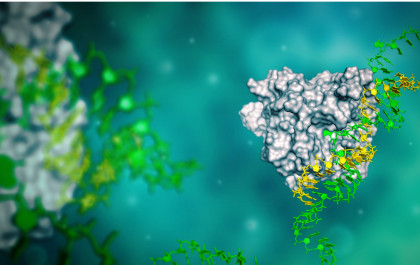ProQR Announces Additional Sepofarsen Illuminate Trial Analyses and Provides Update on Company Strategy
- Post-hoc analyses from Illuminate trial of sepofarsen demonstrate an encouraging efficacy signal when comparing active treatment and sham eyes to their corresponding contralateral eyes across multiple endpoints – Company plans to discuss findings with regulators in Q3
- Illuminate results and post-hoc analyses to be presented at the upcoming Seventh Annual Retinal Cell and Gene Therapy Innovation Summit and the ARVO 2022 Annual Meeting
- Corporate strategy to focus on accelerating the development of Axiomer® RNA base-editing technology platform across multiple therapeutic areas; Company to continue development of select Inherited Retinal Disease (IRD) programs, subject to regulatory feedback
- Company will implement restructuring initiatives including a 30% workforce reduction, extending cash runway into 2025
- Conference call today at 8:00am EDT
LEIDEN, Netherlands & CAMBRIDGE, Mass., April 13, 2022 (GLOBE NEWSWIRE) --
ProQR Therapeutics N.V. (Nasdaq: PRQR) (the “Company”), a company dedicated to changing lives through the creation of transformative RNA therapies, today provided an update on its sepofarsen program, following a comprehensive post-hoc analysis of the data from the Phase 2/3 Illuminate trial in people with CEP290-mediated Leber congenital amaurosis 10, or LCA10, a severe inherited retinal disease. The Company also announced the completion of an in-depth strategic review designed to extend the Company’s runway and deliver on its commitment to advance RNA therapies for diseases with high unmet need.
Strategy update
Based on the outcomes of this strategic review, the Company will prioritize the following strategic objectives:
- Genetic eye diseases – Explore development path for selected ophthalmology programs based on comparing active treatment and sham eyes to their corresponding contralateral eyes, subject to regulatory feedback from the European Medicines Agency (EMA) and US Food and Drug Administration (FDA)
- RNA editing technology – Accelerate development of the Axiomer® RNA base-editing technology platform, including an initial focus on liver, central nervous system (CNS), and the eye.
The Company ended 2021 with €187.5 million of cash and cash equivalents on its balance sheet and expects these resources, together with anticipated expense reductions resulting from a corporate restructuring and the strategic update announced today, will fund currently planned operations into 2025, and through several milestones, including the potential readout of the modified Phase 2/3 Sirius trial of ultevursen.
New findings from sepofarsen Illuminate analysis
Following the top-line announcement in February 2022 that Illuminate, ProQR’s pivotal Phase 2/3 trial of sepofarsen in CEP290-mediated LCA10, did not meet the primary endpoint of Best Corrected Visual Acuity (BCVA) at Month 12 compared to a sham procedure control group, comprehensive post-hoc analyses of the trial were undertaken which revealed:
- No technical errors in the trial conduct, data handling, or the drug product used.
- The overall safety profile of sepofarsen was consistent with earlier trials.
- When the effect in the treatment eye was compared to the untreated contralateral eye in the same patient, at Month 12, a benefit in vision was observed as a mean change from baseline in BCVA of -0.12 logMAR (n=23) in the sepofarsen treated groups. This effect was not observed in the sham treated group (n=12) with the same comparison (treated vs. contralateral eye).
- Other endpoints showed similar effect when comparing treatment to contralateral eye, including Full Field Stimulus Testing (FST).
- These findings were supported by the patient reported outcomes (PRO) analyses, based on the Patient Global Impressions-Change (PGI-C) that demonstrated that 61% of patients in the treatment groups reported an improvement in vision, as well as by Visual Function Questionnaire 25 (VFQ-25).
Overall, the post-hoc analyses showed that the efficacy signal seen with sepofarsen when comparing active treatment and sham eyes to their corresponding contralateral eyes across BCVA, FST, and other endpoints, including PROs, was more consistent with the results seen in earlier findings, where the contralateral eye was used as the control. Based on these results, ProQR will focus on the following core activities related to sepofarsen:
- In Q3, the Company plans to meet with the EMA and FDA to discuss these data from the Illuminate trial. Following this discussion, ProQR will share an update in Q3 or early Q4, depending on timing of regulatory meetings.
- Based on the recommendation of the Data Safety and Monitoring Committee (DSMC), the Company currently plans to continue Illuminate, which is a 2 year study, the Brighten pediatric study, and Insight, until further regulatory guidance, after which next steps will be determined. No further investments are planned at this time for new trials of sepofarsen or commercial preparations.
“These post-hoc analyses show an encouraging efficacy signal when comparing the active treatment and sham eyes to their corresponding contralateral eyes across multiple endpoints and are consistent with feedback received from the investigators. In prior interactions, EMA preferred the use of the contralateral eye as a control, however the protocol was ultimately harmonized globally to use a parallel sham group based on US regulatory requirements,” said Aniz Girach, MD, Chief Medical Officer of ProQR Therapeutics. “While we were disappointed by the outcome of the primary analysis, we believe that these post-hoc analyses and the observation that approximately a third of the patients benefited across multiple concordant endpoints in this trial, in combination with the high unmet need in LCA10, warrants a discussion with the regulators.”
Data from the Illuminate trial will be presented at the upcoming Seventh Annual Retinal Cell and Gene Therapy Innovation Summit, April 29, 2022, and the Association for Research in Vision and Ophthalmology (ARVO) Annual Meeting, May 1-4, 2022.
Operational updates
The Company will implement the following portfolio prioritization and restructuring initiatives with the aim to reduce expenses:
- Focus the ultevursen (QR-421a) program for USH2A-mediated Usher syndrome and retinitis pigmentosa on a single Phase 2/3 Sirius trial with the potential addition of an interim/futility analysis in 2023. Updates on planned adjustments to the Sirius trial in light of the findings related to sham control will be provided after alignment with regulatory authorities;
- Suspend development of QR-1123 for autosomal dominant retinitis pigmentosa and QR-504a for Fuchs endothelial corneal dystrophy;
- Suspend all other IRD-related research activities; and
- Reduce the workforce by approximately 30%, which will include the departure of our Chief Scientific Officer Naveed Shams, MD, PhD, expected to be effective in Q2.
These efforts are expected to extend ProQR’s cash runway into 2025.
Axiomer® RNA editing platform technology
The Company will accelerate the development of its Axiomer® RNA editing platform and pipeline activities and expand into areas beyond the eye, including initially liver and CNS, which have strong alignment with ProQR’s oligonucleotide delivery approaches.
In parallel, ProQR will continue to execute on its partnership with Lilly and selectively enter into additional partnerships designed to advance and capture the full potential value of the platform. Since the Company discovered its RNA editing technology in 2014, it has established a leading IP estate in the ADAR editing space, a first industry partnership, and with its broad applicability the platform has significant further potential.
ProQR will present further non-clinical data for Axiomer® and announce its internal development targets in H2 2022.
“We are focusing our strategy on accelerating our Axiomer® RNA-base editing platform technology, and a select pipeline of RNA therapies for inherited retinal diseases as we remain committed to developing RNA therapies for patients with high unmet need” said Daniel A. de Boer, Founder and CEO of ProQR Therapeutics. “ProQR has a strong cash position with runway into 2025, and we look forward to continued progress with the business, including providing an update following our discussions in Q3 with the EMA and FDA, and sharing details of our development plans for Axiomer® in the second half of 2022.”
De Boer continued, “These have been extremely difficult decisions to make as we position the business to drive long-term growth and value. I want to thank the employees separating from ProQR for their significant contributions toward our mission. I also want to acknowledge the disappointment that many in the eye disease community may feel today, particularly individuals and families living with autosomal dominant retinitis pigmentosa and Fuchs endothelial corneal dystrophy as we wind down our programs for these indications."
“We believe deeply in the promise of RNA therapies, the Company’s pioneering efforts in this field, and ProQR employees,” said Dinko Valerio, co-founder and Chairman of ProQR’s Supervisory Board. “These are the right steps to take to offer the best opportunity to create long-term value for all of our stakeholders, including our shareholders whom we thank for their support, and the communities we aim to serve.”
Conference call and webcast details
Company management will host a call today, April 13, 2022, at 8:00am EDT to discuss this announcement. The live and archived webcast of the presentation will be accessible through this webcast link, or through the Events page of the Company’s website. The dial-in details for the call are +1 631-510-7495 (US) and +31 (0) 20 714 3545 (NL), conference ID: 6487386. The archived webcast will be available for approximately 30 days following the presentation date.
About Leber Congenital Amaurosis 10 (LCA10)
Leber congenital amaurosis (LCA) is the most common cause of blindness due to genetic disease in children. It consists of a group of diseases of which LCA10 is the most frequent and one of the most severe forms. LCA10 is caused by mutations in the CEP290 gene, of which the c.2991+1655A>G (p.Cys998X) mutation has the highest prevalence. LCA10 leads to early loss of vision causing most people to lose their sight in the first few years of life. To date, there are no treatments approved that treat the underlying cause of the disease. Approximately 2,000 people in the Western world have LCA10 because of this mutation.
About sepofarsen
Sepofarsen (QR-110) is an investigational RNA therapy designed to restore vision in Leber congenital amaurosis 10 due to the c.2991+1655A>G mutation (p.Cys998X) in the CEP290 gene. The mutation leads to aberrant splicing of the mRNA and non-functional CEP290 protein. Sepofarsen is designed to enable normal splicing, resulting in restoration of normal (wild type) CEP290 mRNA and subsequent production of functional CEP290 protein. Sepofarsen is intended to be administered through intravitreal injections in the eye and has been granted orphan drug designation in the United States and the European Union and received fast-track designation and rare pediatric disease designation from the FDA as well as access to the PRIME scheme by the EMA.
About Usher syndrome type 2a and retinitis pigmentosa
Usher syndrome is the leading cause of combined deafness and blindness. People with Usher syndrome type 2a are usually born with hearing loss and start to have progressive vision loss during adulthood. The vision loss can also occur without hearing loss in a disease called non-syndromic retinitis pigmentosa. Usher syndrome type 2a and non-syndromic retinitis pigmentosa can be caused by mutations in the USH2A gene. To date, there are no pharmaceutical treatments approved or in clinical development that treat the vision loss associated with mutations in USH2A.
About ultevursen
Ultevursen (formerly QR-421a) is a first-in-class investigational RNA therapy designed to address the underlying cause of vision loss in Usher syndrome type 2a and non-syndromic retinitis pigmentosa due to mutations in exon 13 of the USH2A gene. QR-421a is designed to restore functional usherin protein by using an exon skipping approach with the aim to stop or reverse vision loss in patients. Ultevursen is intended to be administered through intravitreal injections in the eye and has been granted orphan drug designation in the US and the European Union and received fast-track and rare pediatric disease designations from the FDA.
About Axiomer® technology
ProQR is pioneering a next-generation RNA technology called Axiomer®, which could potentially yield a new class of medicines for genetic diseases. Axiomer® “Editing Oligonucleotides”, or EONs, mediate single nucleotide changes to RNA in a highly specific and targeted way using molecular machinery that is present in human cells. The Axiomer® EONs are designed to recruit an endogenously expressed RNA editing system called ADAR, which can direct the change of an Adenosine (A) to an Inosine (I) in the RNA – an Inosine is translated as a Guanosine (G).
About ProQR
ProQR Therapeutics is dedicated to changing lives through the creation of transformative RNA therapies. ProQR is pioneering a next-generation RNA technology called Axiomer®, which uses a cell’s own editing machinery called ADAR to make specific single nucleotide edits in RNA to reverse a mutation or modulate protein expression and could potentially yield a new class of medicines for genetic diseases. Based on our unique proprietary RNA repair platform technologies we are growing our pipeline with patients and loved ones in mind.
Learn more about ProQR at www.proqr.com.
FORWARD-LOOKING STATEMENTS
This press release contains forward-looking statements. All statements other than statements of historical fact are forward-looking statements, which are often indicated by terms such as "anticipate," "believe," "could," "estimate," "expect," "goal," "intend," "look forward to", "may," "plan," "potential," "predict," "project," "should," "will," "would" and similar expressions. Such forward-looking statements include, but are not limited to, statements regarding our strategy and future operations, statements regarding our product candidates, including sepofarsen (QR-110) and the clinical development and the therapeutic potential thereof, statements regarding ultevursen (QR-421a) and the clinical development and the therapeutic potential thereof, statements regarding QR-1123 and the clinical development and therapeutic potential thereof, statements regarding the QR-504a and the clinical development and therapeutic potential thereof, statements regarding our pipeline of programs targeting inherited retinal dystrophies, the potential of our technologies and platforms (including Axiomer®), our other programs and business operations, our current and planned partnerships and collaborators and the intended benefits thereof, our planned interactions with regulatory authorities relating to our programs, our updated strategic plans and the intended benefits thereof, and our financial position and cash runway. Forward-looking statements are based on management's beliefs and assumptions and on information available to management only as of the date of this press release. Our actual results could differ materially from those anticipated in these forward-looking statements for many reasons, including, without limitation, the risks, uncertainties and other factors in our filings made with the Securities and Exchange Commission, including certain sections of our annual report filed on Form 20-F. These risks and uncertainties include, among others, the cost, timing and results of preclinical studies and clinical trials and other development activities by us and our collaborative partners whose operations and activities may be slowed or halted by the ongoing COVID-19 pandemic; the likelihood of our clinical programs being executed on timelines provided and reliance on our contract research organizations and predictability of timely enrollment of subjects and patients to advance our clinical trials and maintain their own operations; our reliance on contract manufacturers to supply materials for research and development and the risk of supply interruption from a contract manufacturer; the potential for later data to alter initial and preliminary results of early-stage clinical trials, including as a result of differences in the trial designs and protocols across different trials; the unpredictability of the duration and results of the regulatory review of applications or clearances that are necessary to initiate and continue to advance and progress our clinical programs; the outcomes of our planned interactions with regulatory authorities; the ability to secure, maintain and realize the intended benefits of collaborations with partners; the possible impairment of, inability to obtain, and costs to obtain intellectual property rights; possible safety or efficacy concerns that could emerge as new data are generated in research and development; our ability to maintain and service our loan facility with Pontifax and Kreos; general business, operational, financial and accounting risks; and risks related to litigation and disputes with third parties. Given these risks, uncertainties and other factors, you should not place undue reliance on these forward-looking statements, and we assume no obligation to update these forward-looking statements, even if new information becomes available in the future, except as required by law.
Cautionary note on future updates
The statements contained in this press release reflect our current views with respect to future events, which may change significantly as the global consequences of the ongoing COVID-19 pandemic rapidly develop. Accordingly, we do not undertake and specifically disclaim any obligation to update any forward-looking statements.
ProQR Therapeutics N.V.
Investor contact:
Sarah Kiely
ProQR Therapeutics N.V.
T: +1 617 599 6228
skiely@proqr.com
or
Hans Vitzthum
LifeSci Advisors
T: +1 617 430 7578
hans@lifesciadvisors.com
Media contact:
Robert Stanislaro
FTI Consulting
T: +1 212 850 5657
robert.stanislaro@fticonsulting.com


